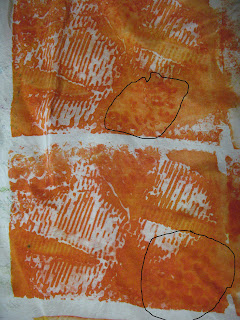Kerr showed us her Deconstructed Screen Print technique and I had fun with it. I have done two semesters of screen print in my course and really loved the last part best, printing on silk with dye, so expected to enjoy this process too.
Basically, we used alginate and procion dyes to put images onto silk and cotton. I must admit, I used silk mostly as I LOVE silk. We had to prepare for the workshop by soaking our silk and cotton in soda ash, which surprised me as it is not recommended for silk. Kerr told us we should have it washed out within two weeks. It gets washed out in the rinsing process after dyeing but I have some still unused, so must get that done tomorrow.
Kerr deliberately didn't talk about colour and we just made up two reds, two blues, a yellow and black. As we were learning a new technique, we didn't need to fuss about colour theory at the same time. The dyes were mixed into a paste and added to alginate.
We started by laying low profile objects under our screen to give texture to it. Then we put coloured alginate over our screen, picking up detail from the objects lying under the screen. We could mix the colours on the screen if we wanted to. The screen had to dry before we could use it again - typical of screen print, always waiting for things to dry!
 |
| There are labels identifying the various textures. Click image to see bigger. |
Then we put clear alginate on the screen and pulled. As the alginate wets the previous laying of texture on the screen, the colour starts to come through to the fabric. It starts off relatively lightly, gets darker as it gets wetter and then starts to lose the colour.
 |
| Circles areas are bubble wrap, must be popped to get good texture. Corrugated cardboard gave most of the texture. |
If there is still texture on the screen, you can put in other coloured alginate and get yet another change.
 |
| There was still texture but the colour had run out of the screen, so I added more coloured alginate. |
It is a very free medium, difficult to plan, especially at my novice level. I loved it, there are no mistakes. If you don't like what you did, you can just wait for it to dry (yes, more waiting) and then overprint. Wonderful.






